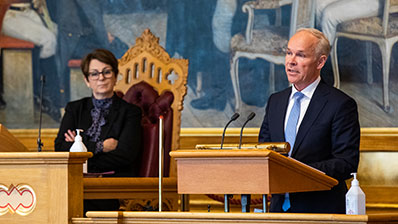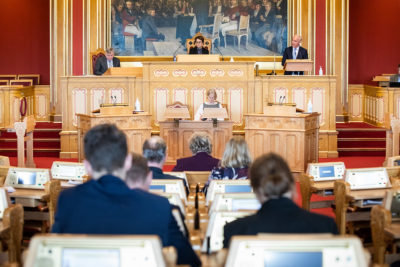Even after proposing to spend unprecedented amounts of state money on more crisis packages and emergency aid, Finance Minister Jan Tore Sanner faced lots of disappointment Wednesday after presenting the government’s revised state budget for this year. Battles also loom over how deeply the government should dip into the state’s Oil Fund to finance its response to the Corona virus crisis.

One thing is clear: Norway’s economy is likely to get much worse before it gets better. The state budget is based on new and sobering predictions that the economy will contract by at least 4 percent this year, and that unemployment will remain at its highest levels since World War II.
That means much less tax revenue flowing into state and local coffers. Other economists at both Norges Bank and state statistics bureau SSB (Statistics Norway) think the economic downturn will be even worse than the government predicts. The central bank predicts gross national product will decline by 5.2 percent, and SSB predicts a decline of 5.5 percent.
That justifies, in Sanner’s and Prime Minister Erna Solberg’s minds, their new raid on Norway’s ultimate piggy bank, the sovereign wealth fund that’s been pumped up by oil revenues since 1996. Before Corona changed everything, they’d planned to only tap the fund for an amount equal to 2.6 percent of the value of its assets, and even less next year. They’re allowed, under spending restrictions known as the handlingsregel, to withdraw as much as 3 percent of the Oil Fund’s value.
Now their revised state budget implies withdrawing 4.2 percent this year alone, with the kroner amount (NOK 419.6 billion) almost twice what they’d previously allowed themselves. “It’s expensive, but necessary,” Sanner said at a press conference following his presentation of the new state budget in Parliament. He admitted that the spending level is “historic,” but less costly in the long run than allowing far more businesses to go bankrupt or risking entrenched long-term unemployment.

The government’s Corona relief measures, expected to cost at least NOK 160 billion, “will ease the way out of the crisis,” Sanner said. They include everything from cash support for businesses and enhanced unemployment payments, to lots more money for hospitals, airports, public transportation, aid to airlines and the hard-hit travel industry, athletics, culture, education and local governments. In addition come tax relief packages including a controversial one worth NOK 100 billion for the oil industry, to encourage companies to keep investing in offshore projects. The goal is to retain jobs and competence in offshore supply businesses.
The actual raid on the Oil Fund may not be as dramatic as many claim, since the so-called handlingsregel was 4 percent until just a few years ago. There’s also another standard rule that allows the government to exceed the current 3 percent rule in times of crisis. That’s being applied now.
“The Corona bills are high, we’re spending lots of money now, but that also means we can spend less in the years ahead,” Sanner told Norwegian Broadcasting (NRK). “The alternative would be even more bankruptcies, even more people out of work and an even longer recovery period for the Norwegian economy.”

He still faced criticism from the opposition in Parliament and, not least, from local government officials who claim they need even more extra funding than they’re getting. They’re due to get at least an extra NOK 2 billion, on top of an extra NOK 20 billion from before, and they were granted a postponement of a new state mandate that they reduce property tax rates. Complaints nonetheless poured in from both sides: the conservative Progress Party still wants property taxes imposed by local governments to be cut, while local governments including Oslo still want to not only retain them but they demand more funding as well.
“Oslo has been the epicenter of the Corona epidemic in Norway and has the highest unemployment,” complained the head of Oslo’s city government, Raymond Johansen of the Labour Party, to newspaper Dagsavisen. “I had expected the government would extend us some consideration, but instead they’re sending the bill back to our people. They’re forcing cuts in welfare and making the crisis worse.”
Not so, retorted the government minister in charge of local governments (kommuner), Nikolai Astrup of the Conservatives. “There is no reason for Oslo to cut welfare for its residents,” Astrup said, noting that local governments have already received an extra NOK 20 billion from the state “with more to come.” Other local politicians in Oslo have also criticized Johansen’s government for spending large sums on projects that have nothing to do with the Corona crisis, like buying up private-sector day care centers so the city can run them instead, instead of devoting more money to Corona relief. Others fear Johansen and other local politicians will use the Corona crisis as an excuse if they cut back on public services. It was also Johansen’s decision to close all bars and cut off all serving of alcoholic beverages in restaurants as well, which forced most to shut down.
Johansen was far from the only one disappointed, though. Sports and athletics organizations were also unhappy with their budget allocations and want more money. Even companies that organize charter tours to warmer climes were complaining, with Astrid Bergmål of the national employers’ organization NHO telling DN that she and her members in the travel industry were “incredibly, incredibly disappointed.” She fears “catastrophe” for businesses that for years have organized air travel, hotel and tour packages for Norwegians traveling abroad.
Then there were those wagging their fingers at the government because they think the Solberg government is spending too much on Corona relief measures. “The increased use of Oil Fund money must not become a habit,” editorialized newspaper Aftenposten. Many other countries, however, likely envy how Norway has so much petrokroner stashed away that it doesn’t have to borrow money to help its citizens. Calls were also rising, within the Progress and Labour parties, to dip even deeper into the Oil Fund “to secure the most jobs.”
NewsInEnglish.no/Nina Berglund

